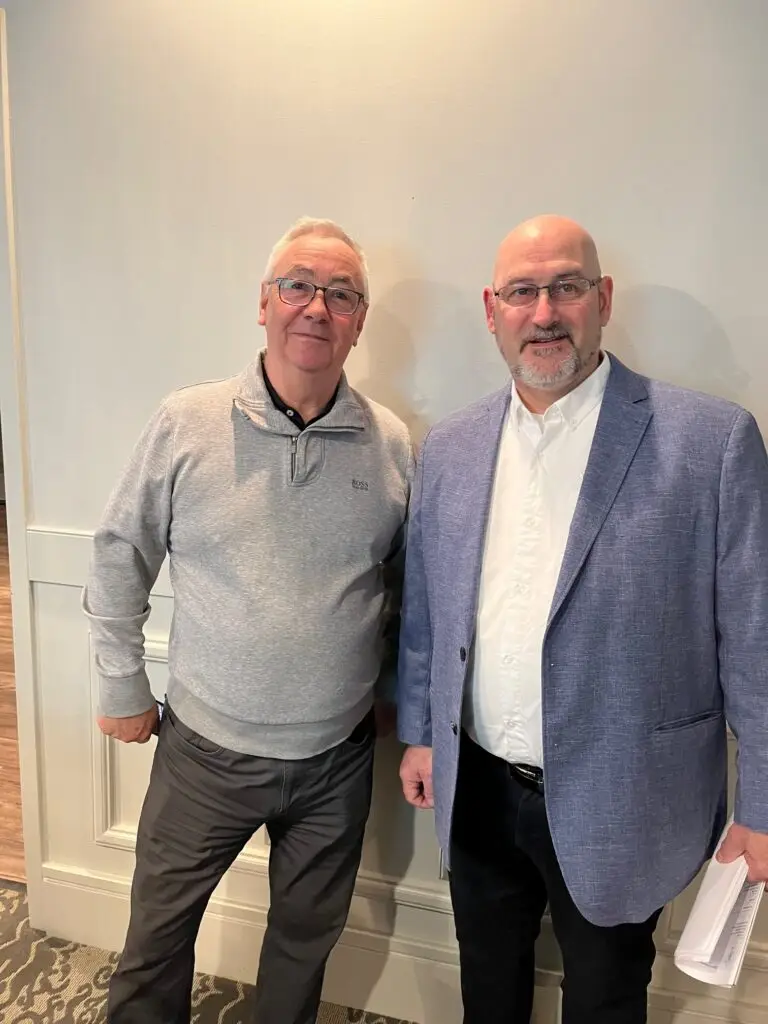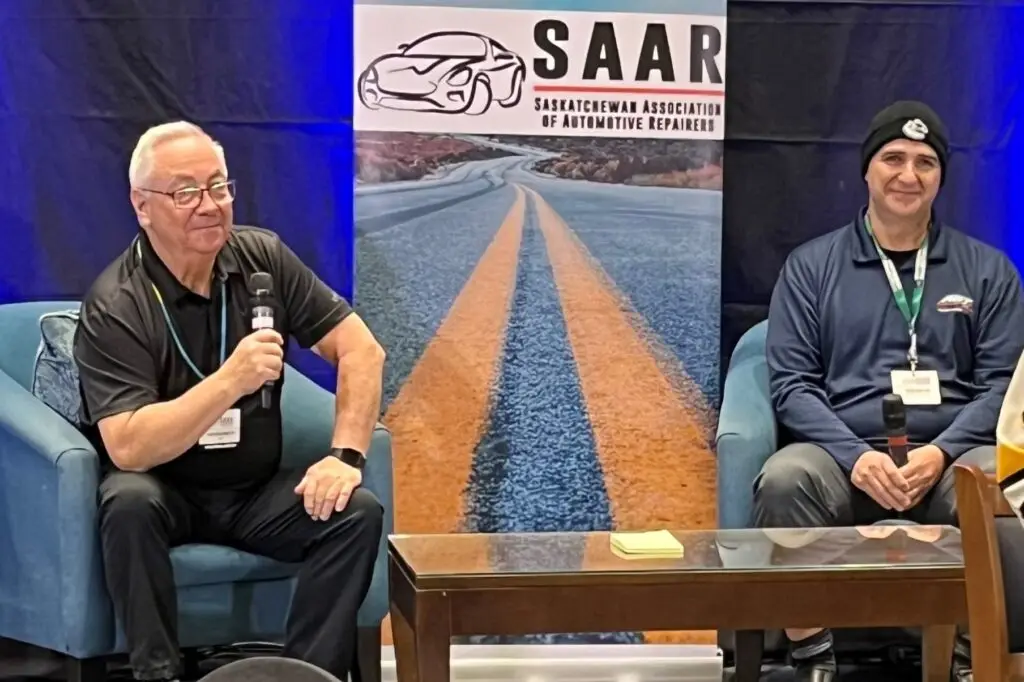Cover photo: (L-R) Tom Bissonnette, SAAR’s executive director, discusses the origins of APT Auto Parts with John Abu-Ata from B.C.
The Saskatchewan Association of Automotive Repairers' (SAAR's) annual spring conference, held in Moose Jaw, Saskatchewan, on March 1–2, 2024, offered attendees a fantastic lineup of speakers. However, challenging weather conditions led to several days of flight cancellations.
Text and photos: David Ribeiro, senior industry relations advisor, Automotive Retailers Association (ARA)
The conference began with a day-time session offered by Stefano Liessi, Color Compass Corporation’s training and curriculum coordinator. The discussion involved a common theme for many in the industry and its associations: “What’s being left on the table?”
Stefano placed a heavy emphasis on repair planning, a term misrepresented by many, but our reference involves a process where the vehicle is fully disassembled for estimating, and then reassembled and returned to the customer until all the parts are in stock. The benefit is greater estimate quality, but most importantly, increased efficiency, employee satisfaction, KPI’s, and ultimately—greater profitability. When you couple this with review tools and processes, it helps ensure that you have accounted for OEM and insurance guidelines.
Conference attendees, representing approximately 30 shops, were led through an initial review of an estimate before the application of theory and tools. Later, a second and more thorough review was conducted that applied that knowledge, and participants came away with a new perspective on how to ensure they consider requests for all the operations required when completing a vehicle repair. Understanding and applying tools such as Mitchell “P” pages (CEG – Collision Estimating Guide), and bulletins such as multiple destructive weld testing requirements for variations in size, thickness, and materials being welded, were reviewed. It was also stressed that to support dialogue with insurers, the industry has at its disposal the information contained within those materials and OEM requirements.
Other tools included I-CAR’s RTS (Repair Technical Support), which tells you if information is available, the DEG (Database Enhancement Gateway) degweb.org, which provides vehicle specific estimating database errors (and where you can submit a request for change or clarification), and finally, the SCRS (Society of Collision Repair Specialists), which provides links to OEM sites as well as a guide to a repair planning tools that help ensure that you have considered all of the potentially required operations mentioned earlier.
The final tool for consideration was EstimateScrubber. When considering the number of steps and operations involved in preparing an estimate (which can easily go beyond 2-3 hours), you need a mechanism to ensure that you have considered the proper application of insurance policy and procedures.
Stefano’s session ended on a final consideration, your dialogue with your insurance representatives. Using terms that support your position were discussed (terms that emphasize your attempt to uphold and maintain the highest standards), versus using terms to try to justify your position (terms that look like excuses or infer concerns). But what about the feedback that you receive from insurers? We discussed expressions such as “the cost of doing business,” a phrase that we know can only be applied to what enables you to run your business, and we also discussed everyone’s favourite, “We don’t pay for that.” When asked how many in the room had been told by an insurer that “they were the only ones who charge for that,” everyone put up their hand. When presented with this line, Stefano simply recommended that you ask for definitive proof of where the policy in question is written.
In the late afternoon, SGI gave a presentation that outlined a new program that recognizes and supports the PDR (Paintless Dent Repair) industry. Fortunately, hail is not that frequent in B.C., but after seeing this snowstorm in the prairies, and knowing about the freak storms in California, perhaps I should have taken notes.
On the second day of the conference, there were a total of 11 presentations on various compelling topics; however, one in particular provided a “WOW” moment, and that was the discussion on AI.
Ryan Taylor of Body Shop Booster was first up to discuss developments in AI, and his presentation left many attendees considering how AI applications might apply to them. Ryan’s presentation style is enthusiastic. He started with some remarkable data to set the stage and open our eyes to the rationale for these types of products: 47% of consumers expect service after hours, and 43% of consumers on your website drop-off and don’t make it to your shop for an estimate.
With AI, you can organize all of your customer contact and interaction information, resulting in 32% greater customer volume while obtaining a 27% efficiency gain for your front-end staff. How does this work? Ryan offered a demonstration in which AI handled a customer call about a vehicle needing repair. The AI walked the caller through the necessary operation. It captured all of the pertinent details, and it even sent the caller messages with a link to a photo tool to help capture necessary photos. It also coordinated contact at various points, including a video welcome from the business owner the next day, and a follow up from the painter (one month later) to advise the customer that it was now safe to apply wax to the freshly painted vehicle.
When you consider the number of claims that a shop processes, AI is capable of coordinating hundreds of calls, which frees up staff to focus on critical aspects of ensuring a seamless repair process and better service. When compared to a phone call with a live, human attendant, Ryan’s demonstration clearly indicated how AI can resolve a lack of detail and professionalism.
Ryan also reviewed some technology that is already in place in locations within the USA, and he reviewed UV1, an AI damage detection system that is going into 200 dealerships/shops in the USA. It contains radar and lidar systems where, after driving through the UV1 provides an estimate for damages within six seconds. Why? Dealers recognize that more than 40% of vehicles have the potential for upselling other services while in their possession. Ryan then provided an example of the Tractable Photo AI, which allows for a tractable triage to determine repairability versus a total loss decision, and it can provide a preliminary estimate within 90 seconds. The purpose of all these tools is to increase retention rates and build confidence.

The bottom line—tools such as these will level the playing field:
After Ryan’s presentation, SGI provided updates on its corporate transformation. SGI is changing all of its systems, including licensing and policy. These changes will allow the corporation to increase its communication, , provide for increased quality and accuracy, and allow for the adoption of AI. Part of this transformation will be an increase to the number of driveable claims going direct to repair facilities from 25% to 50%. SGI continues to retain all non-drive estimate generation. Starting April 2024, it is anticipated that the phased roll-out will take one year to complete. One unique feature of note—shops will receive daily batch claim payments.
Following SGI, a presentation was given by Cory Snyder, the director of philanthropy for Teen Challenge, a world-wide organization with 15 locations across Canada that provide a 12-month rehab program for those who suffer from drug and alcohol addiction. The program helps to transform people and families. The sad truth is that only 2% of people who struggle with addiction come forward for help.
Christie Hall of CARSTAR Canada spoke next. Last year, Christie offered an interesting presentation related to the differences between generations. This year, she gave a presentation on how to say no. She stated that of the 40 million people in Canada, only 19,500 or 0.048% are psychologists trained in how to deal with issues. Christie’s discussion focused on how to work with employees to set or reinforce boundaries and provide realistic expectations while remembering to empathize and provide alternatives. Ultimately, the goal is to promote a culture of accountability and open communication where you use active listening and positive language.
Peter Wrong of 3M spoke of 3M’s flagship Skill Development Centre. It boasts a 15,000 sq. ft. facility and covers topics related to technical skills and standard operating procedure (SOP) training. The facility offers training on a number of products, not just 3M’s. The centre provides three-day training programs for auto body repair, as well as a paint refinish program with a specialized booth that allows 16 technicians to operate comfortably side by side.
Finally, the conference concluded with a special guest speaker from B.C., John Abu-Ata. John sat down with SAAR Executive Director Tom Bissonnette to discuss APT Auto Parts and his remarkable business (and family) story. The dialogue was open and refreshing, revealing how John’s family came to Canada with nothing but their clothes and built a business that supports the industry in Canada’s western provinces (now with 118 staff). Yes, Saskatchewan, it appears you will soon have an APT Auto Parts location to provide you with the service the others have come to trust.

